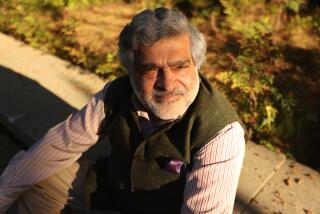India’s Queen Lear : MOTHER INDIA; A Political Biography of Indira Gandhi, <i> By Pranay Gupte (A Robert Stewart Book / Charles Scribner’s Sons: $24.95; 320 pp.)</i>
- Share via
Indira Gandhi (1917-1984) is one of those rare political leaders about whom everything is documented yet very little is understood. As the daughter of India’s first prime minister, Jawaharlal Nehru, and granddaughter of pre-independence Congress Party president Motilal Nehru, she was born and raised in a fishbowl. The questions confronting a biographer are those of character and motivation, not raw fact. Pranay Gupte’s political biography of Indira Gandhi, “Mother India,” is very long on details but skirts central questions of her character. In the end, we get far more than we want to know, and much less than we need to know.
As First Daughter, she was given access to the finest education in India, on the continent (she retained her excellent French all her life) and in Britain. She charmed teachers and classmates everywhere, but failed to secure any degree. She was even sent down from Oxford. She defied her father by marrying an affable no-account (later alcoholic and womanizer) from the tiny Parsi community, Feroze Gandhi, a shopkeeper’s son. (Feroze eventually found his mark as a crusading parliamentarian and journalist; his early death in 1960 enabled Indira to enter politics as a widow and not a divorcee).
The couple had two disappointing sons: Sanjay, a thug, and the valiantly ordinary Rajiv, whose assassination in 1991 ended dynastic politics in India. The reasons for the failure of her marriage remain a mystery, but Indira apparently favored the palatial Allahabad estate of her family and the excitement of high-level politics to her husband’s modest digs.
Indira followed her father as leader in 1966 (after the death of Lal Bahadur Shastri) and enjoyed two glorious successes, one political and the other diplo-military. She broke up the decrepit “Syndicate” of old-line Congress king-makers (her father’s coalition of corrupt and condescending state bosses), thus splitting the Congress Party for all time, and she intervened in the Pakistani civil war of 1971, defying both the United States and China in the process, which led to the creation of Bangladesh and the establishment of India as south Asia’s major military power. Had she died that year, her place in history would have rivaled her father’s, as a defender of Indian democracy and of international decency.
Those are the facts; here are the debatable points:
According to most experts, her own character flaws--pettiness, despotism, paranoia, ruthlessness--destroyed her reputation and her father’s democratic legacy, and left the country, arguably, ungovernable. All but a few analysts--and those few, like New York professor Ralph Buultjens and Forbes editor James W. Michaels, who are quoted copiously and lavishly praised in Gupte’s book--would agree that Gandhi squandered her advantages as the only acknowledged “national” leader after Nehru that the party ever produced. The question is, why did she do it? Was it hostility to her father and his circle? Vengeance for her mother’s humiliations? A woman’s attempt to earn respect (and fear) in a sexist society? Whatever the answers, the implications extend back to myth and classical tragedy. She was the loneliest of leaders, more Queen Lear than Mother India.
I think only Salman Rushdie got it totally right, in “Midnight’s Children,” coining the word sperectomy (the removal of hope) for her legacy, and calling attention to the ever-widening streak of gray in her hair as a sign of the Manichean duality of her character. Laxman, the Times of India’s brilliant cartoonist, captured another part of her political style by having her intone, during one of Bombay’s periodic bouts of fascist rioting in the early ‘70s, “The stoning of Udipi (south Indian) restaurants is a global phenomenon.”
She was by no means unique among politicians in globalizing local problems, scapegoating unseen domestic enemies or blaming other countries (the dread “foreign hand,” which meant the CIA) for all her difficulties. Her formidable talent for denial, and for presenting herself as a gentle little woman struggling to do the best for her people, is a role, and a performance, worthy of a great artist. We know from Gupte that she was shy and diffident at the beginning of her career; we do not learn, however, how the later confidence arose.
Pranay Gupte’s study of Indira and her times is the general reader’s first opportunity to look behind the Potemkin trappings of Indira Gandhi’s “Raj,” her 1966-1977 and 1980-84 rule. The author’s stated ambition is to create a three-tiered portrait of Indira Gandhi: directly through her life, then reflected through her times and place, and finally, a personal account of his own reaction, traveling about India and conducting interviews in the wake of her assassination and after. Underlying all three levels is a deeper desire--to elevate the general American consciousness about India’s status and achievements. Surely that desire is not misplaced; India’s decline is relevant to America’s social and economic panic, and current political impotence.
What results, however--due to chaotic structuring that shuttles back and forth over the same material, sometimes repeating paragraphs verbatim, removing characters only to restore them a few pages later, endlessly reminding the reader of India’s “vastness” and its status as the “world’s largest democracy” (I winked out after the 10th such reference)--is an elaborate wedding cake that got smashed before delivery. Only the ingredients are present, without shape or appetizing substance.
Chaos is one problem, but I think what is more distressing is the author’s recapping of other scholars’ work, particularly that of Inder Malhotra, senior correspondent for several Indian papers whose own “Indira Gandhi: A Personal and Political Biography” stands unchallenged as the major interpretation of her life and legacy. In fact, apart from the interlinear first-person accounts of his own travels and interviews, this is the longest book I have ever read without significant original research, or analysis, to justify it.
Gupte seems to be of two minds about Indira Gandhi. He takes no exception to some extraordinary quotes by his friend (and the book’s dedicatee) Buultjens, an unabashed Gandhi apologist. Buult-jens asks, “Did the leader leave (her) country behind in better shape than when (she) found it? In a larger sense, Indira Gandhi meets this test well.” Particularly difficult to fathom, after her destabilization efforts in Kashmir, Punjab, Andhra Pradesh and Tamil Nadu, is the professor’s later assertion of Gandhi’s having “sustained the unity and integrity of India.”
At other times, Gupte argues the other side: Gandhi was the opposite of her father, seeking confrontation rather than consensus; seeing disloyalty--and crushing it--where others might have seen diversity and encouraged it. In his summary, Gupte comes down lightly on the side of her critics: “A contemporary political assessment of Indira Gandhi cannot but be harsh. But perhaps history will measure Indira Gandhi by another yardstick: Did India benefit from her stewardship, with all its strengths and flaws? And the answer may well be in the affirmative, if Indira’s vision of a united and secular India withstands the vicissitudes of today’s destructive politics.”
My answer would be: If India survives and advances, it will be quite literally over her dead body, and over her discredited policies. The destructive politics are intertwined with her autocratic visions of unity.
It is unfortunate that Gupte’s attempts to assess the times and character of Indira Gandhi are marred by structural difficulties and poor writing: fulsome does not mean copious, and Gupte should certainly know that “Maruti,” the name of Sanjay’s failed automobile enterprise, was not the monkey-god of the Ramayana. Once the excess is stripped away--pages of little more than acronyms and raw statistics, or non-reappearing names and places--one is still left with the curious omission of any substantive discussion of the “Emergency,” perhaps the single defining act of Gandhi’s years in power. The only “Emergency” was a court-judgment against her for election fraud. Rather than surrender her office, she placed the country under “Defense of India” and “Maintenance of Internal Security Act” (MISA) rules. For two years she ran the country as a dictatorship, silencing the press, imprisoning opposition, even voiding the judgment against her. She elevated Sanjay and his cronies to undreamed-of wealth and power, gutted the independent judiciary, and tolerated arbitrary abuses of every sort.
The memories of those abuses led to her defeat in 1977. After her return to power in 1980, Gandhi concentrated on destroying political culture wherever it thwarted her designs, unseating democratically elected and reasonably loyal non-Congress state governments in Kashmir, Punjab, and in the south (where she was defeated). The sordid meddling with the Sikh-dominated government of the Punjab, cynically using the fanatic Bhindranwale as her cat’s paw, then losing control of the movement that he headed, led eventually to anarchy and the army’s invasion of the Golden Temple, the death of Bhindranwale and Indira’s own assassination by her Sikh bodyguards.
The guilt for the butchery of thousands of civilians and government officials in all parts of the country and even outside it (such as the bombing of an Air-India flight out of Canada that killed 319 innocent civilians) is partially on her hands. Her intolerance of criticism and demand for lap-dog loyalty from all parts of a diverse and fractious country are the sources of the intractable regional and religious problems faced by her successors today.
In the end, Gupte’s desire to elevate the tone of press coverage of India in the West by using the life of Indira Gandhi is defeated by the unsavory spectacle of Indira herself, her cronies and her debased political milieu. Yes, there are still noble souls in India, devoted to the democratic ideals of Nehru or the social commitment of Mahatma Gandhi. And yes, Indira’s excesses often were matched in the behavior of Nixon and Johnson. But Indira Gandhi is the problem of India itself. Ponder the waste of her talents and opportunities, and you are not very likely to champion the country’s potential. The only good that I can think of coming out of her rule is ironic: realism. We now compare India to its neighbors--not, as Gandhi’s father wanted, to the finest traditions of Western democracy.
India was, briefly, high ground in the low-lying alluvia of south Asia. It was--and still is--preferable to any political culture in the region. It had honest government, idealistic public servants, a viable industrial and a responsive academic base, a spirited print media, a distinctive and dynamic culture, a world-conscious, secular and democratic policy, and a military that knew to stay in the barracks. These component parts of progress still exist, scattered about an increasingly fragile landmass, but there are serious questions to be raised about reassembling them and finding the skills to get them to run again.
More to Read
Sign up for our Book Club newsletter
Get the latest news, events and more from the Los Angeles Times Book Club, and help us get L.A. reading and talking.
You may occasionally receive promotional content from the Los Angeles Times.






